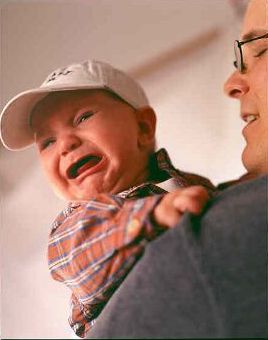I don’t know you!
Scotty is eight months old, and he’s a cheerful and outgoing baby. He always smiles at people and delights in experiencing the world around him.
But not today.
When his mother brings in a new babysitter, she’s surprised by her child’s reaction. Not only does Scotty fail to smile and respond, but as the sitter reaches out to touch him, Scotty clings closely to his mother and begins to whimper. A few minutes later, when Mom tries to leave the room, Scotty’s distress turns into full-blown sobs. What happened to her happy, outgoing baby?
I’m scared
Scotty’s reactions to the new babysitter are normal. By around seven to nine months, most babies begin to show fear. Often this fear shows up when babies see unfamiliar people, like a new babysitter or a family member they haven’t seen for a while. This fear is called “stranger anxiety.” Babies also begin to show fear when their parents or caregivers leave them with others, even if it is at home or some other familiar place. This fear is called “separation anxiety.” Although these fears seem troubling, don’t worry—children worldwide develop these fears at about the same age.
Why he’s frightened now
Why does fear develop around seven to eight months? Some researchers believe children begin to show fear when they can compare something they know and remember with something they don’t recognize. In this view, stranger anxiety results from children’s increasing ability to remember and recognize familiar faces and places. In other words, as children learn the difference between familiar and unfamiliar faces, they may become more fearful of faces they don’t know (Lewis & Haviland-Jones, 2000).
Others believe that fear is more biologically “programmed.” For these researchers, an unfamiliar face or situation is a natural clue to danger. They believe infants may be programmed to fear strange faces and settings as part of a survival strategy because any strange or unfamiliar creature could be potentially threatening (Bowlby, 1973; Shaffer, 1999).
What we know
Whatever the reason, stranger anxiety is a normal part of a child’s development that begins around seven to nine months. For example, one study observed a group of babies growing from age four months to twelve months. Here’s how it worked:
Each month, researchers watched the babies’ reactions as they were approached by someone they didn’t know. These strangers walked up to the babies, greeted them, picked them up, and held them. At eight months old, even with the mother present, many children began frowning, whimpering, or crying with the stranger. By nine months, 79% of the babies showed fearful reactions (Emde, Gaensbauer, & Harmon, 1976).
In another study, researchers found that how a stranger acts made a difference. When the strangers approached more slowly and didn’t try to touch or pick up the baby, babies showed less “stranger” anxiety. The same was true when the mother or a familiar caregiver was present (Sroufe et al., 1977).
Please don’t leave me!
“But why does my 11-month-old start crying and fussing when I leave her with an unfamiliar babysitter?” There’s nothing strange about the person or the place, yet her reaction is much different than just a few months ago. This is separation anxiety. It usually appears between six and eight months, gets stronger at about thirteen to fifteen months, and becomes less frequent and less intense as the baby gets older (Kagan, Kearsley & Zelazo, 1978).
Most young children get upset when their mothers or other familiar caregivers leave them, even for brief periods of time. As children grow to feel a strong attachment to their parents or caregivers, seeing them leave is scary. And while it may be heartbreaking for a parent to leave a crying child, the child is showing that she has reached an important developmental milestone. The young child feels an emotional bond with the parent, and that is a good thing!
When leaving your child with someone, communicate to your child that he will be safe and that you will be back soon.
- Earlier in the day, let your child know how long you will be gone, who will be there with them, and what they will be doing when you are gone.
- Give your child some time with the babysitter so he can get more comfortable before you leave.
- Let your child know that the caregiver will keep him safe.
- For older children, tell them how much you love them, where you are going, and when you’ll be back.
- Give them something to look forward to when you return, like reading a book or playing together.
Being afraid is not fun
Children are unique, and they will respond in different ways to strangers and to being separated from you. Fear is a very normal reaction – just another part of growing older. Be open to trying different things as your child develops, and trust your instincts. As your child grows, remember that these powerful fears—and the tears—will fade over time.
Helpful parenting tips
- Stay close to your child when new people are around. Infants react more fearfully to strangers when their mothers or caregivers are not nearby.
- Show your child that new people are okay. When you greet a new person in a friendly way, with smiles and a positive tone of voice, children are less likely to feel afraid.
- If you’re taking a child to a new place, help her feel more comfortable by:
- Give your child time to get used to new surroundings before meeting someone new.
- Try bringing a familiar toy or stuffed animal for comfort.
- Encourage new people to approach slowly and gently without immediately touching your child.
- Avoid sneaking out on your child when leaving. Although it might seem easier at the time, children may feel confused or betrayed when they realize you’re gone.

